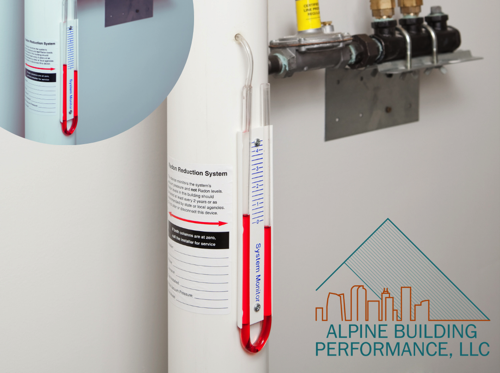The pressure gauge on a radon mitigation system, commonly known as a U-tube manometer or pressure gauge, is a simple device that measures the differential pressure in the radon mitigation system. This gauge DOES NOT tell you the radon levels in the home. It helps indicate whether the system is functioning correctly by showing the level of suction or vacuum being created by the fan that pulls radon gas from beneath the house and vents it outside.
How the Pressure Gauge Works:
- U-Shape Tube: The gauge typically consists of a clear, U-shaped tube partially filled with a colored liquid (often water or oil-based).
- Pressure Difference: One side of the U-tube is connected to the vent pipe, while the other side is open to the atmosphere. The liquid in the tube will be at different levels on each side if the fan is working properly, creating a pressure differential.
- Measurement: The difference in the liquid levels, usually measured in inches, indicates the suction pressure. The exact value can vary, but typically, the liquid on the side connected to the vent pipe will be lower than the side open to the atmosphere.
What the Readings Mean:
- Normal Operation: If the system is functioning properly, the liquid in the U-tube should have a noticeable difference in height between the two sides, indicating that the fan is creating sufficient suction.
- No Suction (Equal Levels): If the liquid levels are the same on both sides, it suggests that there is no pressure difference, meaning the fan may not be working, the system could be blocked, or there is a significant leak in the piping.
- Too Much or Too Little Pressure: If the pressure reading is significantly higher or lower than what is typical for your system, it might indicate an issue, such as a clogged pipe or a failing fan. Typically more than 1.5” offset indicates a problem. This could affect the system’s efficiency in reducing radon levels.
Regular Monitoring:
Homeowners should periodically check the pressure gauge to ensure the radon mitigation system is operating correctly. If the levels change significantly or if the liquid levels are equal, it’s a sign that the system needs to be inspected by a professional to ensure it is effectively mitigating radon gas.
So if a Home has an Active Radon Mitigation System Should we Still do a Radon Test?
Good question! I created this Youtube Short video to answer just that question.
Hope you found this info useful! If you need assistance with a home inspection my contact info is below!




